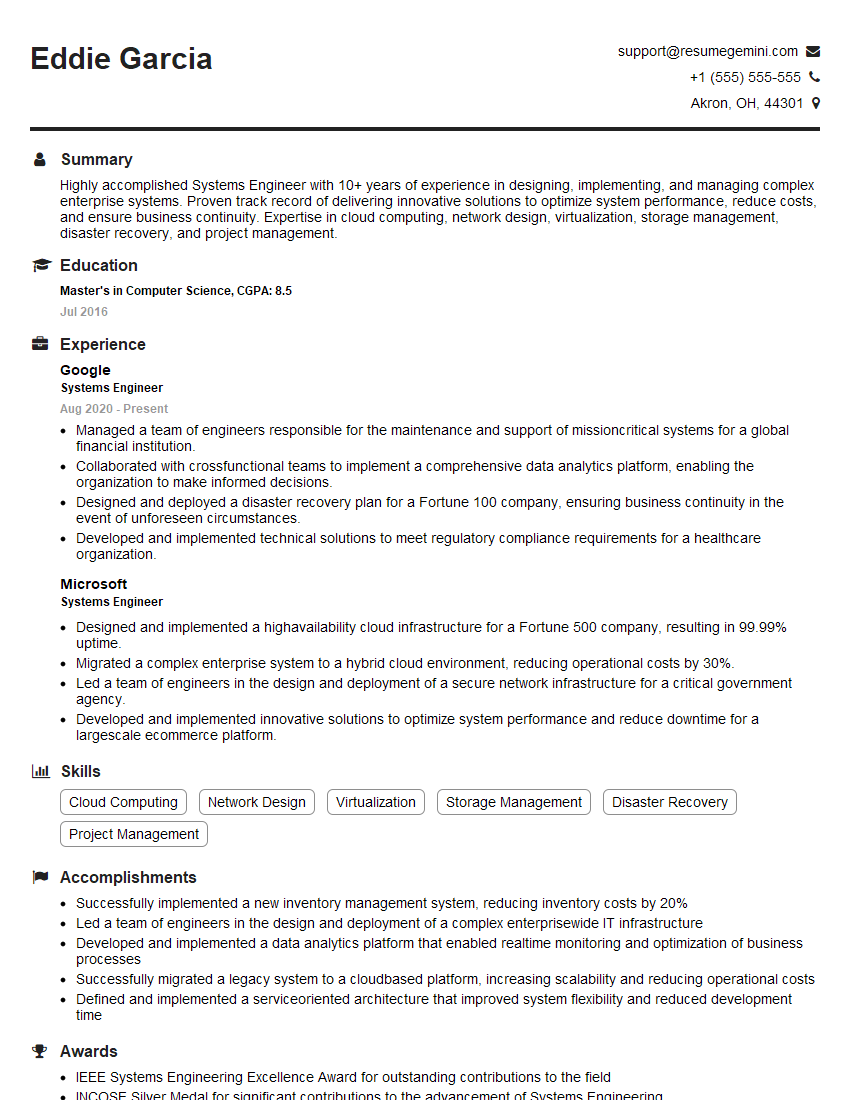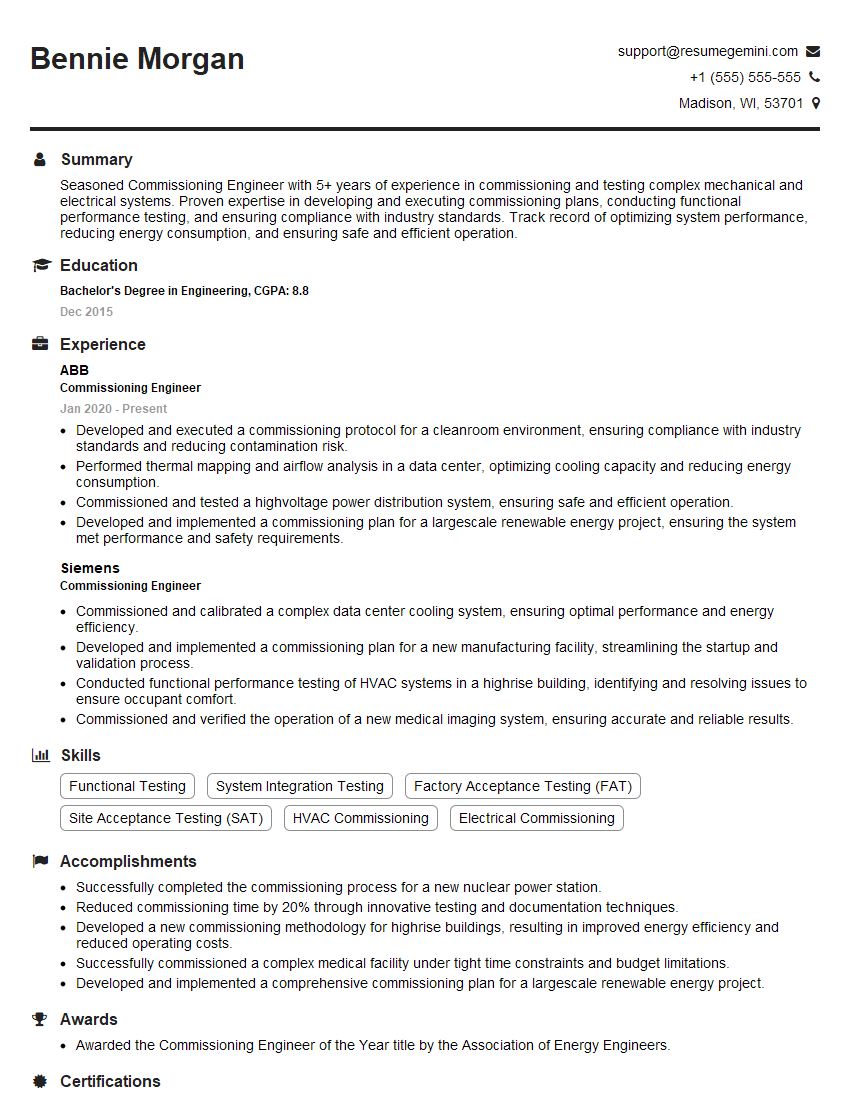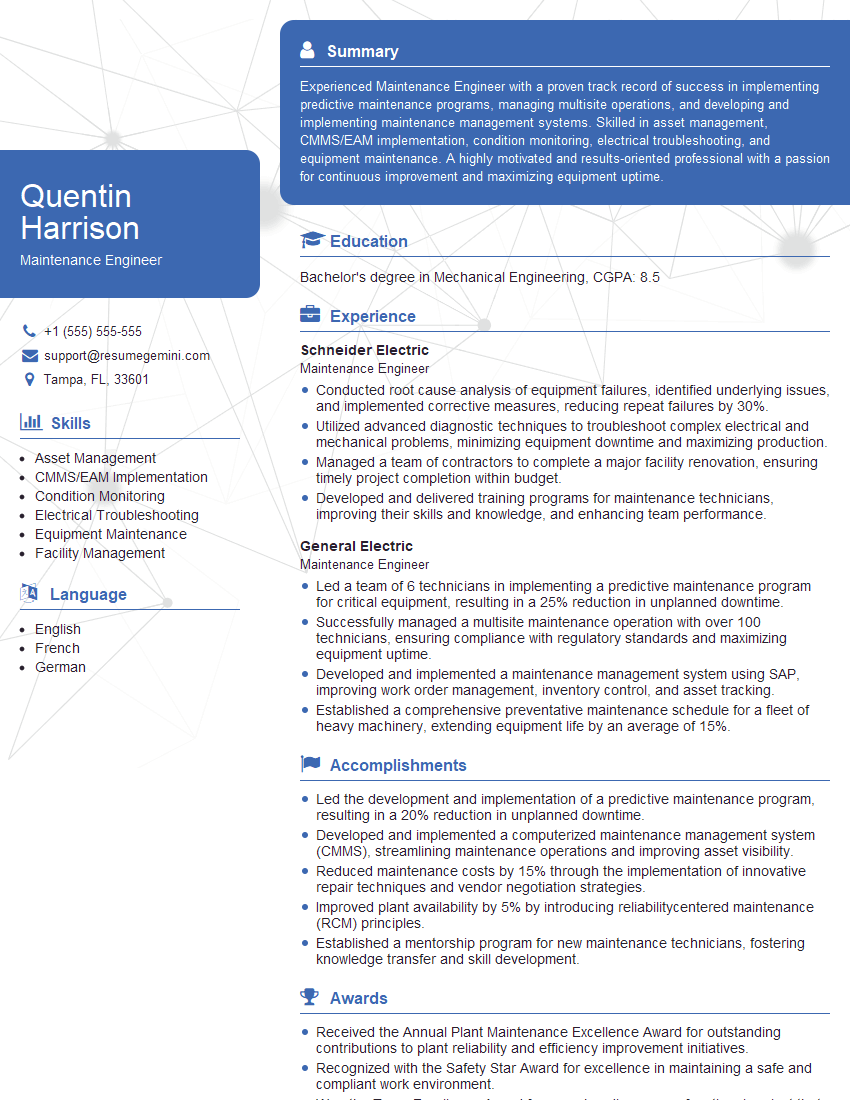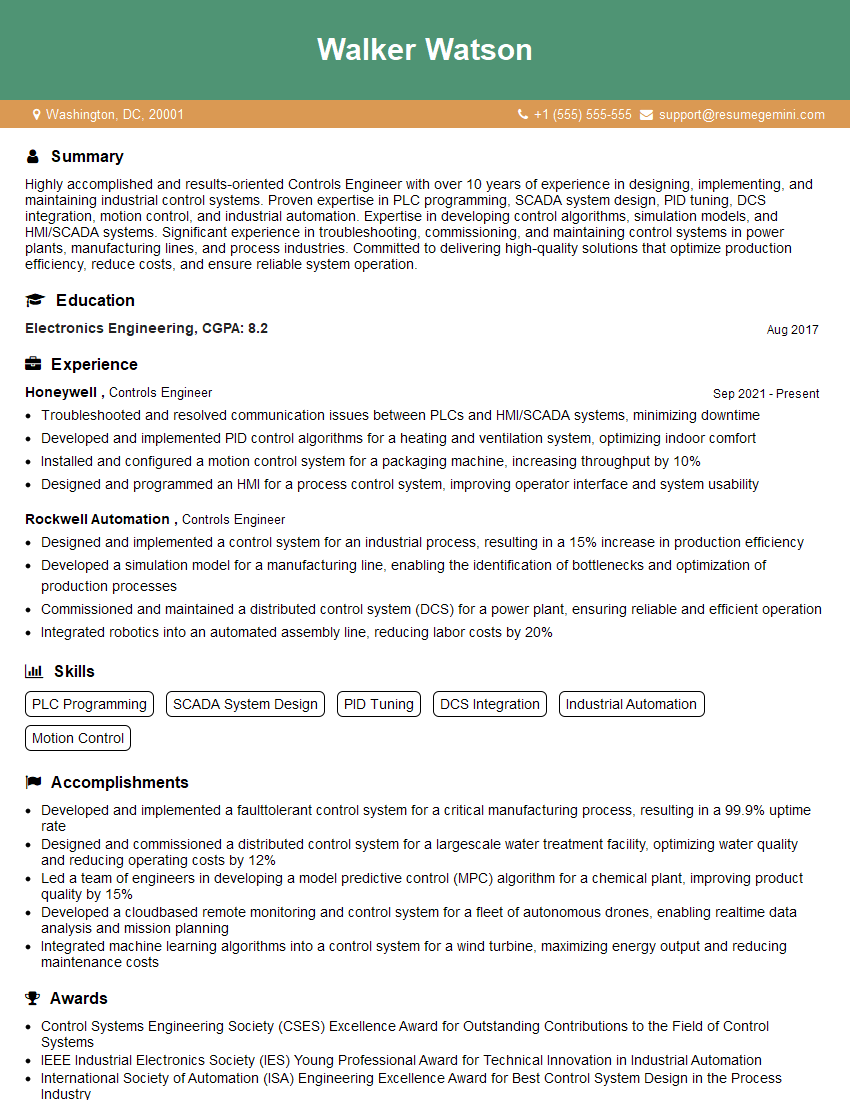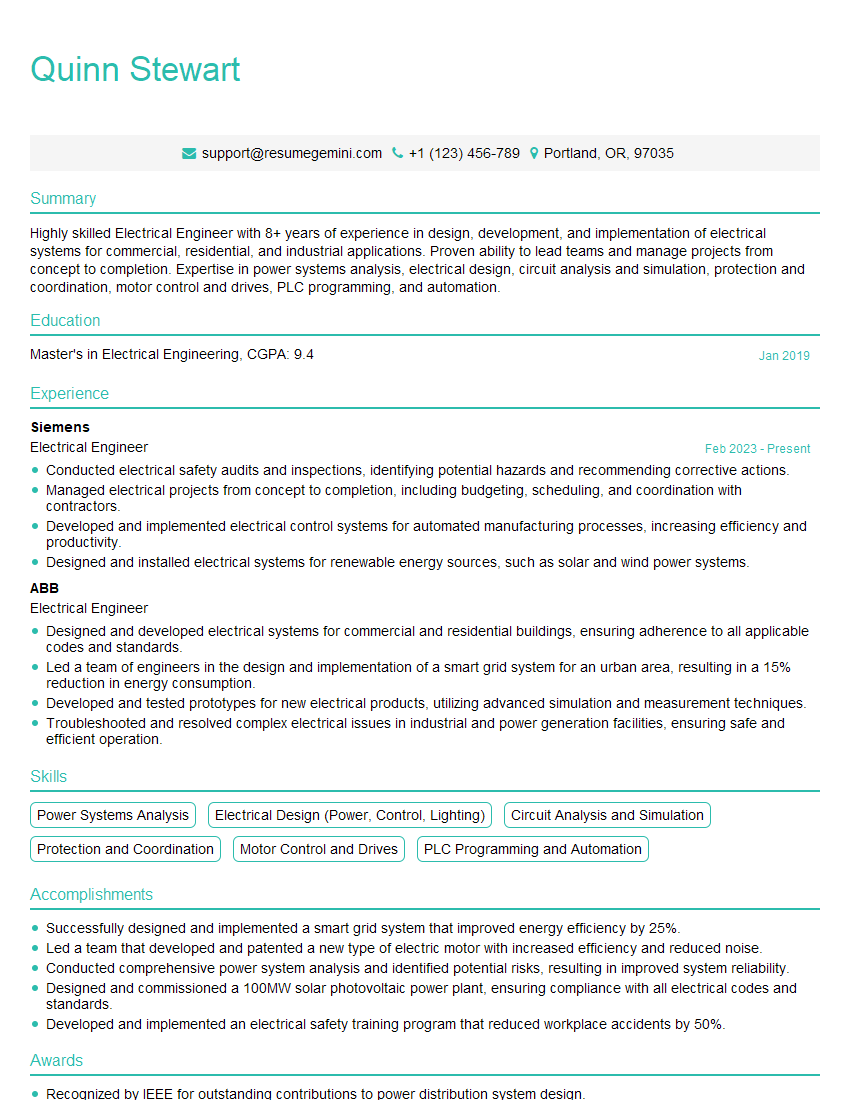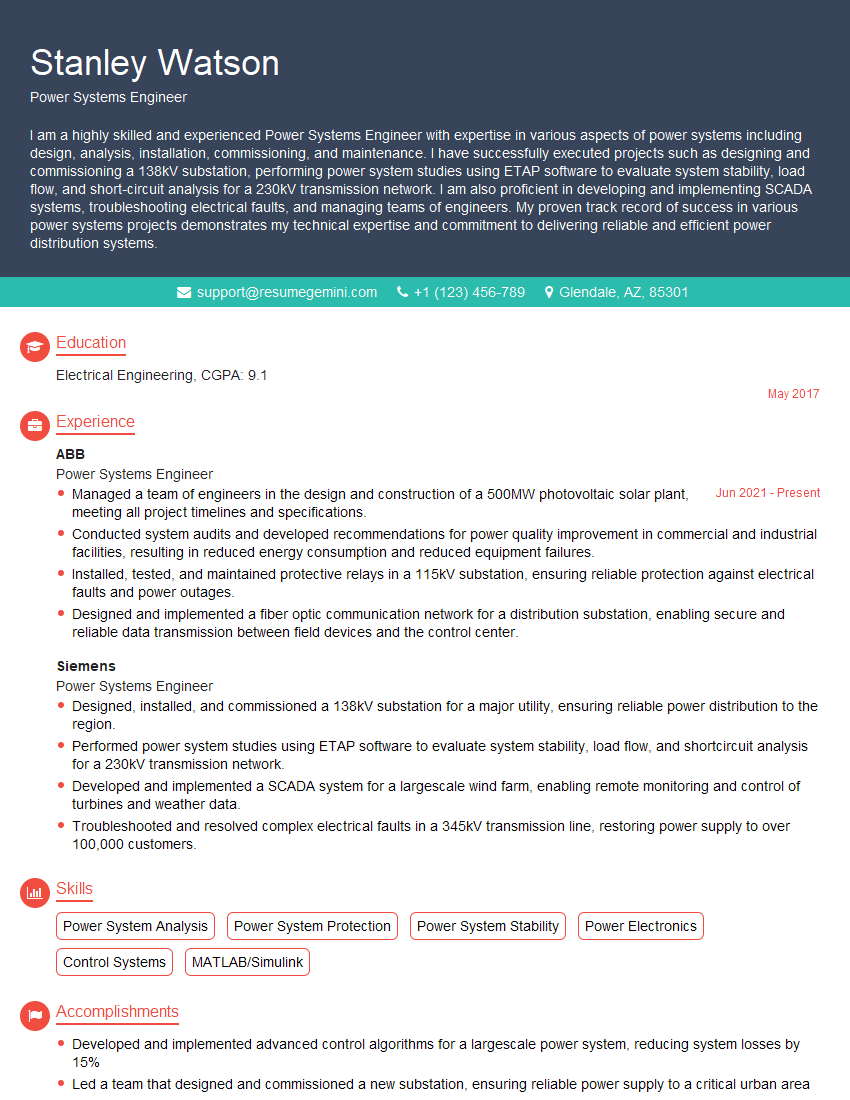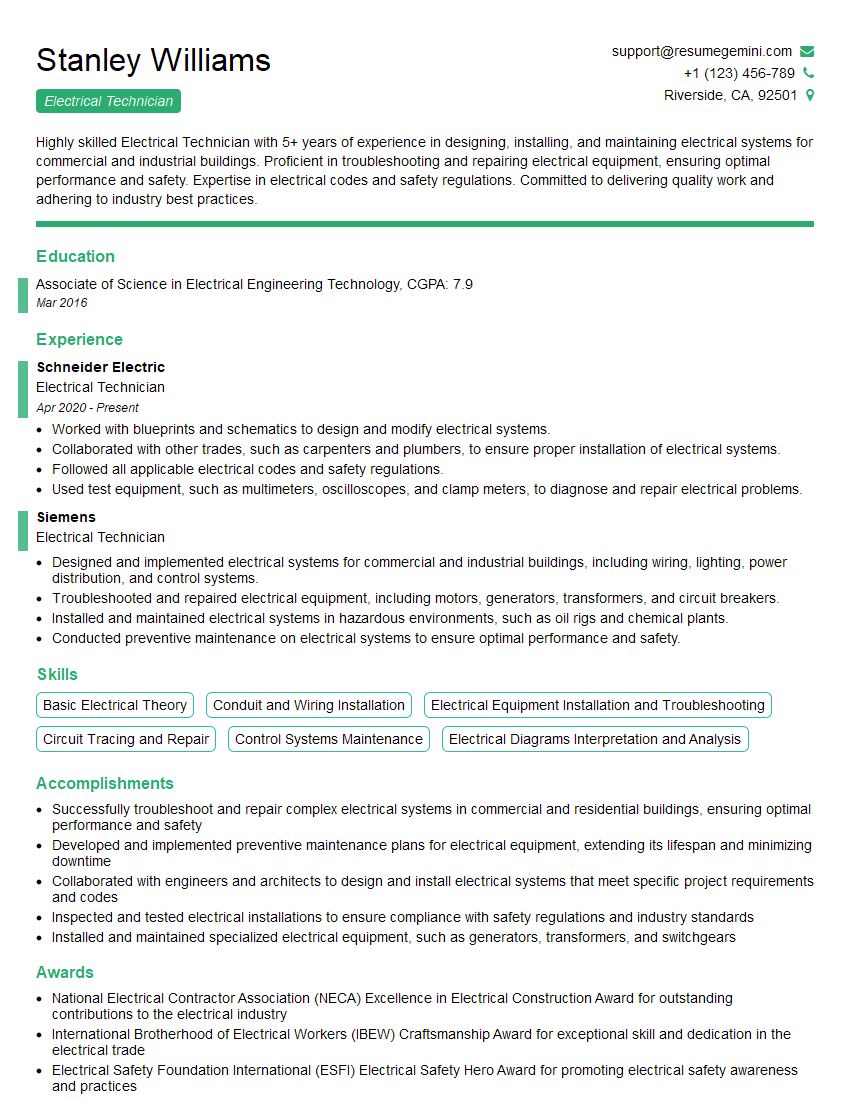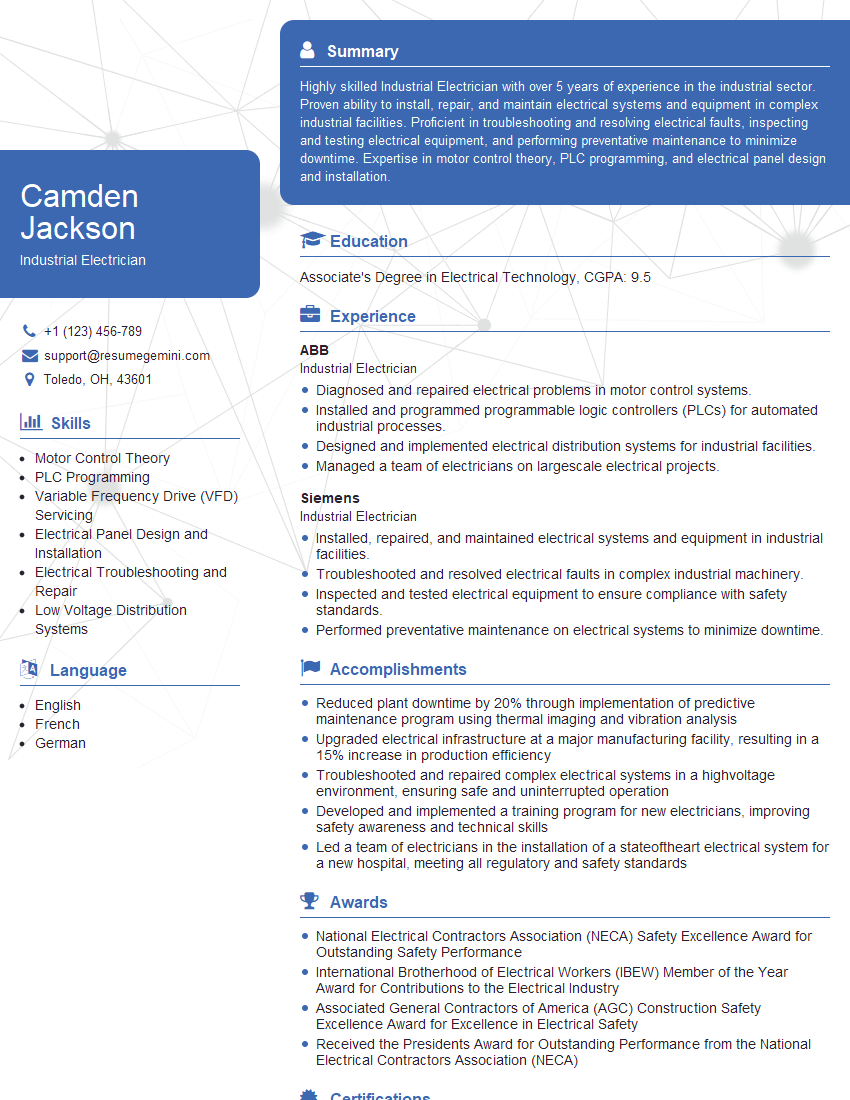The right preparation can turn an interview into an opportunity to showcase your expertise. This guide to Motor Control and Drive Systems with Variable Frequency Drives, Soft Starters, and Contactors interview questions is your ultimate resource, providing key insights and tips to help you ace your responses and stand out as a top candidate.
Questions Asked in Motor Control and Drive Systems with Variable Frequency Drives, Soft Starters, and Contactors Interview
Q 1. Explain the operating principle of a Variable Frequency Drive (VFD).
A Variable Frequency Drive (VFD) controls the speed of an AC motor by adjusting the frequency of the power supplied to it. Think of it like a sophisticated dimmer switch for a motor. Instead of simply turning the power on and off, a VFD manipulates the electrical waveform itself. It does this by converting the fixed frequency AC power from the grid into DC, then back into AC at a variable frequency.
This variable frequency directly affects the motor’s synchronous speed, as the motor’s speed is directly proportional to the frequency of the supplied power. By increasing or decreasing the frequency, we can smoothly accelerate or decelerate the motor. Furthermore, the VFD also adjusts the voltage to maintain the correct voltage-to-frequency ratio, preventing motor overheating and ensuring efficient operation across the speed range.
The process involves several key stages: rectification (AC to DC), DC bus filtering (smoothing the DC), PWM (Pulse Width Modulation) inversion (DC to variable frequency AC), and output filtering (smoothing the variable frequency AC). Each stage is crucial for efficient and controlled motor operation.
Q 2. What are the advantages and disadvantages of using VFDs compared to other motor speed control methods?
VFDs offer significant advantages over other motor speed control methods like mechanical means (e.g., gears, pulleys) or simple on/off control with contactors. Here’s a comparison:
- Advantages of VFDs:
- Precise speed control: Enables smooth acceleration, deceleration, and precise speed regulation.
- Energy savings: Reduces energy consumption by matching motor speed to the load’s requirements.
- Reduced wear and tear: Eliminates the abrupt starting and stopping that can damage mechanical components.
- Improved process control: Provides better control and responsiveness in various industrial processes.
- Enhanced motor life: Gentle starting and reduced stress extend the lifespan of motors.
- Disadvantages of VFDs:
- Higher initial cost: VFDs are more expensive than simpler control methods.
- Potential for harmonic distortion: VFDs can introduce harmonic currents into the power system, requiring mitigation measures.
- Complexity: Requires specialized knowledge for installation, commissioning, and troubleshooting.
- Electromagnetic interference (EMI): Can generate EMI, potentially affecting sensitive equipment; proper shielding is necessary.
For instance, a VFD controlling a pump in a water treatment plant allows for precise flow control, reducing energy waste and improving process efficiency compared to using a simple valve.
Q 3. Describe different types of VFDs and their applications.
VFDs come in various types, categorized mainly by their power rating, voltage levels, and control methods:
- Scalar VFDs: These are simpler and less expensive, offering only open-loop speed control (V/f control). They are suitable for applications where precise speed regulation isn’t critical, like simple conveyor belts.
- Vector VFDs: These provide closed-loop speed and torque control through advanced algorithms. They offer superior performance, especially under varying loads, and are ideal for applications requiring precise speed and torque control, such as robotics or CNC machines.
- Single-phase VFDs: Designed for single-phase power supply, primarily used in smaller applications.
- Three-phase VFDs: Used for three-phase motors, common in industrial applications.
- High-performance VFDs: These are specifically designed for demanding applications with rapid speed changes and high precision. They often include advanced features like regenerative braking and encoder feedback.
For example, a vector VFD would be a better choice for a precise positioning application like a robotic arm, while a scalar VFD could suffice for a less demanding application such as a simple fan.
Q 4. How do you select the appropriate VFD for a specific motor and application?
Selecting the appropriate VFD involves several key considerations:
- Motor power rating: The VFD’s power rating must be at least equal to or greater than the motor’s power rating.
- Motor voltage: The VFD’s voltage must match the motor’s voltage.
- Motor type: Different motor types (induction, synchronous, etc.) may require specific VFD features.
- Application requirements: The required speed range, accuracy, and dynamic response of the application dictate the necessary VFD control features (scalar vs. vector).
- Environmental conditions: The VFD’s operating temperature range and enclosure type should be suitable for the environment.
- Communication protocols: The VFD should be compatible with the control system’s communication protocols (e.g., Modbus, Profibus).
A systematic approach, considering these factors and consulting the VFD manufacturer’s specifications, is crucial for ensuring proper selection and reliable operation.
Q 5. Explain the concept of motor starting current and its impact on the power system.
Motor starting current, also known as inrush current, is the high current drawn by a motor when it starts. This current can be several times the motor’s full-load current and is primarily due to the motor’s inertia and the lack of back EMF (electromotive force) at standstill.
This high inrush current can significantly impact the power system by causing voltage dips, tripping circuit breakers, and stressing electrical components. It can also affect other equipment sharing the same power supply, leading to malfunction or disruption. For example, a large motor starting in a factory might cause a temporary voltage drop affecting other machinery, potentially leading to production downtime.
Mitigation strategies include using VFDs (which reduce starting current by controlling voltage and frequency), soft starters (reduce inrush current by gradually increasing the voltage), or oversized cables and transformers to handle the high inrush current.
Q 6. What is the purpose of a soft starter, and how does it differ from a VFD?
A soft starter is a device that reduces the inrush current during motor starting by gradually increasing the voltage applied to the motor. Unlike a VFD, which controls both voltage and frequency, a soft starter primarily controls only the voltage, resulting in a simpler and less expensive solution.
The key difference lies in their capabilities. A soft starter is designed for reducing the mechanical stress on the motor and power system during starting. It offers limited speed control, typically only starting and stopping at full speed. A VFD, on the other hand, provides precise control over both speed and torque throughout the motor’s operating range.
Imagine starting a large pump. A soft starter gradually increases the voltage, preventing a sudden surge of current and reducing mechanical shock. A VFD would do the same but would also allow you to control the pump’s speed after it starts.
Q 7. Describe the different types of soft starters and their applications.
Soft starters are generally classified based on their power handling capability and control method:
- Thyristor-based soft starters: These are the most common type, using thyristors to control the voltage applied to the motor. They are relatively inexpensive and robust but may have limitations in their control accuracy.
- Transistor-based soft starters: These offer more precise voltage control and faster response times than thyristor-based starters but are typically more expensive.
- Autotransformer-based soft starters: These use an autotransformer to gradually increase the voltage. They are suitable for very high-power motors but are bulky and expensive.
The choice depends on the motor size, required starting characteristics, and budget. For instance, a thyristor-based soft starter might be sufficient for a smaller fan motor, while a more sophisticated transistor-based starter or autotransformer-based starter might be necessary for a large industrial pump or compressor.
Q 8. How do you select the appropriate soft starter for a specific motor and application?
Selecting the right soft starter involves careful consideration of the motor’s characteristics and the application’s demands. Think of it like choosing the right car for a specific journey – a small car is fine for city driving, but you’d need an SUV for off-road adventures. We need to match the starter’s capabilities to the motor’s needs.
Firstly, determine the motor’s rated voltage, current, and horsepower. The soft starter must have a voltage and current rating equal to or greater than the motor’s. Next, consider the motor’s inertia. High-inertia loads, like large pumps or conveyors, require soft starters with higher inrush current handling capabilities and potentially more sophisticated control algorithms to manage the acceleration smoothly. The application’s demands also play a crucial role. For example, a delicate process might necessitate a soft starter with fine-tuned control over acceleration and deceleration ramps to avoid shock or damage. Finally, environmental factors like ambient temperature and enclosure type must be considered to ensure the soft starter’s reliable operation.
Example: A large centrifugal pump starting under full load would necessitate a soft starter with a high current rating and advanced features for smooth acceleration to avoid water hammer and stress on the piping system. Conversely, a small fan motor starting under light load could use a smaller, less expensive soft starter.
Q 9. Explain the function of a contactor in a motor control circuit.
A contactor acts as a remotely controlled on/off switch for a motor, handling high currents with minimal wear compared to a manual switch. Imagine it as a powerful, electric relay. It’s triggered by a low-voltage control circuit to switch the high-voltage power circuit for the motor on or off. This separation offers crucial safety and convenience.
The contactor’s main function is to establish and break the high-power circuit to the motor rapidly and reliably. It’s usually part of a larger motor control system, where the contactor receives its switching signals from other components like PLCs, timers, or other control logic.
Q 10. What are the different types of contactors, and what are their applications?
Contactors come in various types, categorized based on their operating mechanism and application. The most common types include:
- AC Contactors: Designed for switching alternating current (AC) loads, common in most industrial motor applications.
- DC Contactors: Used for switching direct current (DC) loads, found in applications such as battery-powered equipment and some industrial control systems.
- Three-phase Contactors: These control three-phase AC motor circuits, the most common type in industrial settings.
- Reversing Contactors: These are pairs of contactors used to control the direction of rotation of a three-phase motor. They are configured to ensure that only one set of contacts is closed at any given time to prevent short circuits.
Applications: AC contactors are prevalent in motor control circuits for pumps, fans, compressors, and other machinery in various industries, including manufacturing, HVAC, and water treatment.
Q 11. How do you select the appropriate contactor for a specific motor and application?
Choosing the right contactor involves a similar process to selecting a soft starter. First, you need the motor’s data: voltage, current, and power. The contactor’s rated voltage and current must be equal to or exceed these values to ensure safe and reliable operation. Consider the motor’s inrush current – the contactor must handle this peak current without damage. The contactor’s coil voltage should match the control circuit’s voltage. The type of contactor (AC, DC, three-phase, reversing) must also align with the motor’s specifications.
Example: A large industrial pump motor will require a contactor with a significantly higher current rating and possibly auxiliary contacts for other control signals than a small residential fan motor.
Other factors to consider include the operating frequency, the number of operations per hour (duty cycle), and the ambient temperature.
Q 12. Explain the importance of motor protection devices in motor control systems.
Motor protection devices are essential to prevent damage to the motor and other components in the system, potentially averting costly repairs or production downtime. These devices act as safeguards, monitoring for various fault conditions and quickly disconnecting the motor to prevent further harm. Think of them as the motor’s ‘bodyguards’, protecting it from potential threats.
These devices monitor parameters such as current, temperature, voltage, and speed, detecting issues like overcurrent, overheating, undervoltage, and ground faults. Failing to implement proper protection can lead to burned-out motors, damaged wiring, and even safety hazards.
Q 13. Describe different types of motor protection devices and their functions.
Several types of motor protection devices exist:
- Overload Relays: These detect excessive motor current due to overload or stalling and trip the circuit breaker to prevent damage. They’re like a fuse, but with thermal protection that responds to prolonged overload.
- Thermal Overload Relays: These sense the motor’s temperature, usually through an embedded thermal sensor, and trip the circuit if it exceeds safe levels, often preventing catastrophic overheating.
- Circuit Breakers: These are electrical switches that automatically interrupt current flow when a fault occurs, like overcurrent or short circuits, providing rapid protection for the entire system.
- Motor Protection Relays (MPRs): These sophisticated devices monitor multiple motor parameters (current, voltage, frequency, power factor, etc.), providing advanced protection capabilities, including fault detection and analysis.
- Fuse: A simpler device designed to melt and break the circuit when the current exceeds its rated capacity.
Q 14. How do you troubleshoot a motor control circuit with a faulty VFD?
Troubleshooting a faulty VFD requires a systematic approach. Start with safety: Ensure the power is disconnected before any inspection. A visual inspection comes first; check for obvious problems like loose connections, burned components, or physical damage. Check input and output voltages using a multimeter, verifying that they meet specifications. Then, inspect the VFD’s display for error codes; these codes provide critical clues about the malfunction. The manufacturer’s manual is your best friend here.
Systematic Troubleshooting Steps:
- Check input power: Verify that the incoming voltage and frequency are correct.
- Inspect the wiring: Look for loose connections, broken wires, or signs of overheating.
- Review VFD parameters: Ensure that the VFD is correctly configured for the motor and application.
- Analyze error codes: Use the VFD’s manual to decipher any error codes displayed.
- Check motor parameters: Verify that the motor is properly grounded and its winding resistance is within acceptable limits.
- Monitor VFD output: Use an oscilloscope or multimeter to monitor the output voltage and current waveforms.
- Test sensors: If the VFD has any sensors (e.g., speed sensors), ensure they are working correctly.
If the problem persists, consider professional assistance from a qualified technician or the VFD manufacturer’s support team.
Q 15. How do you troubleshoot a motor control circuit with a faulty soft starter?
Troubleshooting a faulty soft starter begins with safety! Always ensure the power is completely disconnected before starting any inspection. Then, we systematically check for common issues. First, we verify the incoming power supply – are the correct voltage and frequency present? A simple multimeter check can confirm this. Next, we examine the soft starter’s control signals. Are the start and stop commands being received correctly? A logic probe or oscilloscope can assist here. We also check for any error codes displayed on the soft starter itself; the manual will provide details on these codes. Inspect the motor’s current draw – excessive current could indicate a problem with the motor itself or an overload. Finally, check the soft starter’s internal components for any visible damage, loose connections, or burnt components. Remember, always consult the manufacturer’s documentation for detailed troubleshooting steps and safety precautions. For example, a faulty thermal fuse within the soft starter might cause it to trip unexpectedly; replacing it often solves the issue. Sometimes, the problem isn’t the soft starter itself, but a faulty sensor feeding it incorrect data, such as a faulty temperature sensor leading to a false overload trip.
Career Expert Tips:
- Ace those interviews! Prepare effectively by reviewing the Top 50 Most Common Interview Questions on ResumeGemini.
- Navigate your job search with confidence! Explore a wide range of Career Tips on ResumeGemini. Learn about common challenges and recommendations to overcome them.
- Craft the perfect resume! Master the Art of Resume Writing with ResumeGemini’s guide. Showcase your unique qualifications and achievements effectively.
- Don’t miss out on holiday savings! Build your dream resume with ResumeGemini’s ATS optimized templates.
Q 16. How do you troubleshoot a motor control circuit with a faulty contactor?
Troubleshooting a faulty contactor also prioritizes safety! Power must be OFF. We begin by visually inspecting the contactor for any obvious problems: burned contacts, loose connections, or physical damage. A multimeter can be used to check the coil voltage and the continuity of the contacts. If the coil isn’t receiving the correct voltage, trace the wiring back to the control circuit to find the source of the problem. If the contacts aren’t closing, the coil might be faulty or there might be a problem with the control circuit. We’ll test the mechanical operation of the contactor; sometimes, it can get stuck due to dirt or debris. If the contactor’s contacts are heavily pitted or burnt, they’ll need replacing. Consider auxiliary contacts – these often provide status signals; if these are malfunctioning, it points to a problem with the contactor itself. For instance, a welder’s contactor might fail due to repetitive high-current switching, requiring preventative maintenance like contact cleaning or replacement at regular intervals.
Q 17. Explain the concept of regenerative braking in VFD applications.
Regenerative braking in VFD applications refers to a method where the kinetic energy of a decelerating motor is converted back into electrical energy and returned to the power supply. Imagine a car going downhill – instead of using friction brakes to dissipate the energy as heat, regenerative braking captures that energy and uses it to recharge the battery (in a hybrid car). Similarly, when a motor driven by a VFD slows down, the motor acts as a generator, producing power. A VFD equipped with regenerative braking capability can handle this power, often through an internal braking resistor or by feeding it back to the AC line. This approach improves efficiency, reduces wear on mechanical brakes, and provides smoother, faster stopping. The selection of regenerative braking method depends on factors like motor size, braking requirements, and available power supply. It’s vital to ensure the VFD is correctly configured for regenerative braking to prevent damage to the equipment.
Q 18. How do you design a motor control system with multiple motors and different control strategies?
Designing a motor control system with multiple motors requires careful planning. First, identify each motor’s specific requirements – power rating, speed control needs, torque characteristics, and operating profile. Then, determine the appropriate control strategy for each motor. Some motors might require simple on/off control (using contactors), others might need precise speed regulation (using VFDs), and some could benefit from sophisticated techniques like coordinated motion control. A PLC (Programmable Logic Controller) is often used to manage the overall system, coordinating the operation of the individual motor controllers. For example, in a conveyor system, one motor might control the main drive, another might handle the infeed, and a third might control a divertable section. Each motor might use a different type of control but the PLC synchronizes their actions, ensuring smooth, integrated operation. Safety interlocks and communication protocols (like Profibus or EtherCAT) play crucial roles in ensuring system stability and safety.
Q 19. Explain the importance of safety considerations in motor control system design.
Safety is paramount in motor control system design. Failure to prioritize safety can lead to serious injuries, equipment damage, and production downtime. Key safety considerations include: protecting personnel from electrical hazards (using appropriate enclosures, isolation switches, and emergency stops), preventing mechanical hazards (guarding moving parts, incorporating interlocks), and managing thermal hazards (monitoring motor temperature, incorporating thermal overload protection). Consider potential fault conditions – what happens if the motor overloads, a component fails, or the control system malfunctions? The system must be designed to handle these situations safely, perhaps by incorporating automatic shutdowns, alarms, and fail-safe mechanisms. Compliance with relevant safety standards (like IEC 60204) is essential, and thorough risk assessment is a vital step in designing a safe system. A failure to account for potential hazards can result in expensive downtime, and even worse, serious injury.
Q 20. Describe different safety devices used in motor control systems.
Numerous safety devices enhance motor control system safety. These include Emergency Stop buttons (easily accessible and clearly marked), safety relays (to monitor safety circuits and ensure proper interlocks), thermal overload relays (to protect motors from overheating), proximity sensors (to detect the presence of personnel near hazardous areas), light curtains (to create safety zones around machinery), and interlocks (to prevent operation under unsafe conditions). Circuit breakers protect the system from overcurrents, while fuses provide additional protection for individual components. Grounding and bonding are critical to prevent electrical shocks. The selection of appropriate safety devices depends on the specific hazards associated with a particular system; a thorough risk assessment guides the choice and placement of these devices. Regular inspection and testing of these devices are critical for maintaining system safety.
Q 21. What are the common causes of motor overheating, and how can they be prevented?
Motor overheating can stem from several sources. Excessive load – the motor is being asked to do more work than it’s designed for – is a common cause. Insufficient ventilation – poor airflow around the motor restricts heat dissipation – is another frequent culprit. Mechanical friction – bearings wearing out, misalignment, or imbalance – can generate excess heat. Electrical problems – faulty windings, incorrect wiring, or high resistance connections – can also cause excessive heating. Ambient temperature – if the surrounding environment is too hot, it’ll further contribute to overheating. Prevention involves proper sizing of the motor for the application, ensuring sufficient ventilation, regular maintenance (lubricating bearings, checking for alignment issues), proper electrical connections, and operating the motor within its specified temperature range. Regular thermal inspections using infrared cameras can help detect potential issues before they lead to catastrophic failures. Overheating can drastically shorten motor lifespan and even lead to dangerous situations; proactive monitoring and maintenance are key to prevention.
Q 22. Explain the concept of motor efficiency and its importance in industrial applications.
Motor efficiency refers to how effectively a motor converts electrical energy into mechanical energy. A higher efficiency means less energy is wasted as heat, resulting in lower operating costs and a smaller carbon footprint. It’s expressed as a percentage – for example, a 95% efficient motor means that 95% of the electrical energy input is converted into useful mechanical work, while the remaining 5% is lost as heat.
In industrial applications, motor efficiency is paramount. Industries aim for high-efficiency motors to reduce energy bills, minimize heat generation (improving safety and reducing cooling needs), and contribute to sustainability initiatives. Consider a large manufacturing plant with hundreds of motors; even a small improvement in individual motor efficiency translates into significant cost savings over time. A switch to premium efficiency motors, for example, can easily pay for itself through reduced energy consumption.
Q 23. How do you select the appropriate motor for a specific application?
Selecting the right motor involves carefully considering several factors. First, you need to determine the required power (horsepower or kilowatts) based on the load’s torque and speed requirements. This often involves calculations based on the mechanical characteristics of the application. Next, the duty cycle – whether it’s continuous operation, intermittent operation, or short bursts – plays a critical role. Continuous heavy loads require motors with higher thermal capacity.
Environmental factors also come into play; considering factors such as ambient temperature, humidity, and the presence of corrosive substances influences the choice of motor construction and enclosure type. Finally, other specifications like voltage, frequency, speed control requirements (constant speed vs. variable speed), and mounting configuration need to be matched to the application. Often, a motor selection table or software is used to streamline this process, providing options based on the specified parameters. A crucial step is also to validate the selected motor through simulations or real-world testing to ensure it meets the application’s operational demands.
Q 24. What are harmonic distortions, and how do they affect motor control systems?
Harmonic distortions are unwanted frequencies superimposed on the fundamental frequency (e.g., 60Hz in North America, 50Hz in Europe) of the power supply. These distortions are typically non-linear and result in a distorted waveform. Variable frequency drives (VFDs) are a common source of harmonic distortion because of their pulse-width modulation (PWM) technique, which chops the AC waveform into pulses to control motor speed.
These distortions can negatively affect motor control systems in several ways: Increased motor heating (reducing motor lifespan), causing premature failure of motor bearings and insulation, creating interference with other equipment operating on the same power grid (like sensitive instrumentation), and potentially damaging other equipment connected to the power system. The higher the harmonic order, the more severe the effects often are.
Q 25. How do you mitigate harmonic distortions in VFD applications?
Mitigating harmonic distortion in VFD applications is crucial. Several techniques are employed: Using VFDs with built-in harmonic filtering (such as active front-end (AFE) VFDs), implementing external harmonic filters (passive or active) to absorb or counteract the harmonic currents, selecting VFDs with lower harmonic generation (some designs inherently produce less distortion), and optimizing the VFD settings to reduce harmonic content. For example, carrier frequency adjustments in PWM can minimize harmonic creation. In some cases, a combination of these approaches might be necessary, especially in sensitive applications or installations with a stringent harmonic limit.
Another often overlooked aspect is proper system grounding and earthing. This helps channel harmonic currents safely to ground and prevent them from causing further disturbances.
Q 26. Describe the importance of proper grounding and earthing in motor control systems.
Proper grounding and earthing in motor control systems is critical for safety and reliable operation. Grounding provides a low-impedance path for fault currents, protecting personnel from electrical shocks and equipment from damage. Earthing connects the motor frame and other metal enclosures to earth, reducing the risk of electrical shocks and preventing voltage build-up due to static electricity or induced currents.
A good grounding system ensures that fault currents flow directly to earth, tripping protective devices (circuit breakers or fuses) quickly, thus isolating the faulty equipment and preventing further damage or injury. Inadequate grounding can result in dangerous voltage levels on exposed metal parts, increased harmonic distortion, and inaccurate sensor readings.
Q 27. Explain the role of PLC (Programmable Logic Controller) in motor control systems.
A Programmable Logic Controller (PLC) acts as the brain of a modern motor control system. It’s a digitally programmable device that monitors inputs from sensors, switches, and other devices, processes these inputs based on a programmed logic, and sends output signals to control motors, contactors, and other components. In motor control, a PLC might oversee start-stop sequences, monitor motor speed and current, implement safety interlocks, manage multiple motors in a coordinated manner, and provide data logging and diagnostics.
Think of a conveyor system with multiple motors. A PLC can control the sequence of motor operations, ensuring smooth transitions and preventing jams or other malfunctions. It can also monitor motor parameters and trigger alarms if any deviations from normal operating conditions are detected.
Q 28. Describe different communication protocols used in motor control systems.
Various communication protocols are used in motor control systems, each offering different features and capabilities. These protocols facilitate communication between PLCs, VFDs, sensors, and human-machine interfaces (HMIs). Common protocols include:
- Profibus: A widely adopted fieldbus for industrial automation, offering high speed and robust communication.
- Profinet: An Ethernet-based industrial communication protocol known for its speed and versatility.
- Modbus: A widely used serial communication protocol known for its simplicity and open standard.
- EtherCAT: A high-speed Ethernet protocol optimized for real-time communication in industrial applications.
- CANopen: A communication protocol primarily used in embedded systems and robotics.
The choice of protocol depends on factors like the required speed, distance between devices, network complexity, and cost considerations. Some systems might employ a combination of protocols to best meet their specific needs.
Key Topics to Learn for Motor Control and Drive Systems with Variable Frequency Drives, Soft Starters, and Contactors Interview
- Fundamentals of Motor Control: Understanding different motor types (AC induction, DC, servo), their characteristics, and torque-speed curves. Explore the principles of motor starting and braking.
- Variable Frequency Drives (VFDs): Deep dive into VFD operation, including PWM techniques, vector control, and scalar control. Analyze the advantages and disadvantages of VFDs in various applications.
- Soft Starters: Learn the working principles of soft starters, comparing their functionality and applications with VFDs. Understand their limitations and suitability for specific motor types and loads.
- Contactors: Master the selection and application of contactors for motor starting and stopping. Understand the role of overload relays and safety mechanisms in contactor circuits.
- Power Electronics: Gain a solid understanding of power semiconductor devices (IGBTs, MOSFETs) used in VFDs and soft starters. Familiarize yourself with power electronic circuit topologies.
- Motor Protection: Explore various motor protection methods, including thermal protection, overcurrent protection, and ground fault protection. Understand the role of safety devices in preventing equipment damage and ensuring personnel safety.
- Troubleshooting and Diagnostics: Develop your skills in troubleshooting common motor control problems. Learn how to use diagnostic tools and interpret fault codes from VFDs and other control devices.
- Practical Applications: Explore real-world examples of motor control systems in various industries (e.g., HVAC, manufacturing, process control). Analyze the specific challenges and solutions for each application.
- Control Systems: Understand basic control system concepts, including feedback loops, PID control, and closed-loop systems, as applied to motor control.
- Safety Standards and Regulations: Become familiar with relevant safety standards and regulations related to motor control systems (e.g., NEC, IEC).
Next Steps
Mastering Motor Control and Drive Systems, including proficiency with Variable Frequency Drives, Soft Starters, and Contactors, is crucial for career advancement in many engineering and technical fields. A strong understanding of these systems demonstrates a valuable skillset highly sought after by employers. To increase your chances of landing your dream job, create an ATS-friendly resume that highlights your expertise effectively. ResumeGemini is a trusted resource that can help you build a professional and impactful resume. Examples of resumes tailored to Motor Control and Drive Systems expertise with Variable Frequency Drives, Soft Starters, and Contactors are available to guide you. Invest the time to craft a compelling resume – it’s your first impression with potential employers.
Explore more articles
Users Rating of Our Blogs
Share Your Experience
We value your feedback! Please rate our content and share your thoughts (optional).
What Readers Say About Our Blog
Hi, I represent an SEO company that specialises in getting you AI citations and higher rankings on Google. I’d like to offer you a 100% free SEO audit for your website. Would you be interested?
Hi, I represent an SEO company that specialises in getting you AI citations and higher rankings on Google. I’d like to offer you a 100% free SEO audit for your website. Would you be interested?
Dear Sir/Madam,
Do you want to become a vendor/supplier/service provider of Delta Air Lines, Inc.? We are looking for a reliable, innovative and fair partner for 2025/2026 series tender projects, tasks and contracts. Kindly indicate your interest by requesting a pre-qualification questionnaire. With this information, we will analyze whether you meet the minimum requirements to collaborate with us.
Best regards,
Carey Richardson
V.P. – Corporate Audit and Enterprise Risk Management
Delta Air Lines Inc
Group Procurement & Contracts Center
1030 Delta Boulevard,
Atlanta, GA 30354-1989
United States
+1(470) 982-2456

